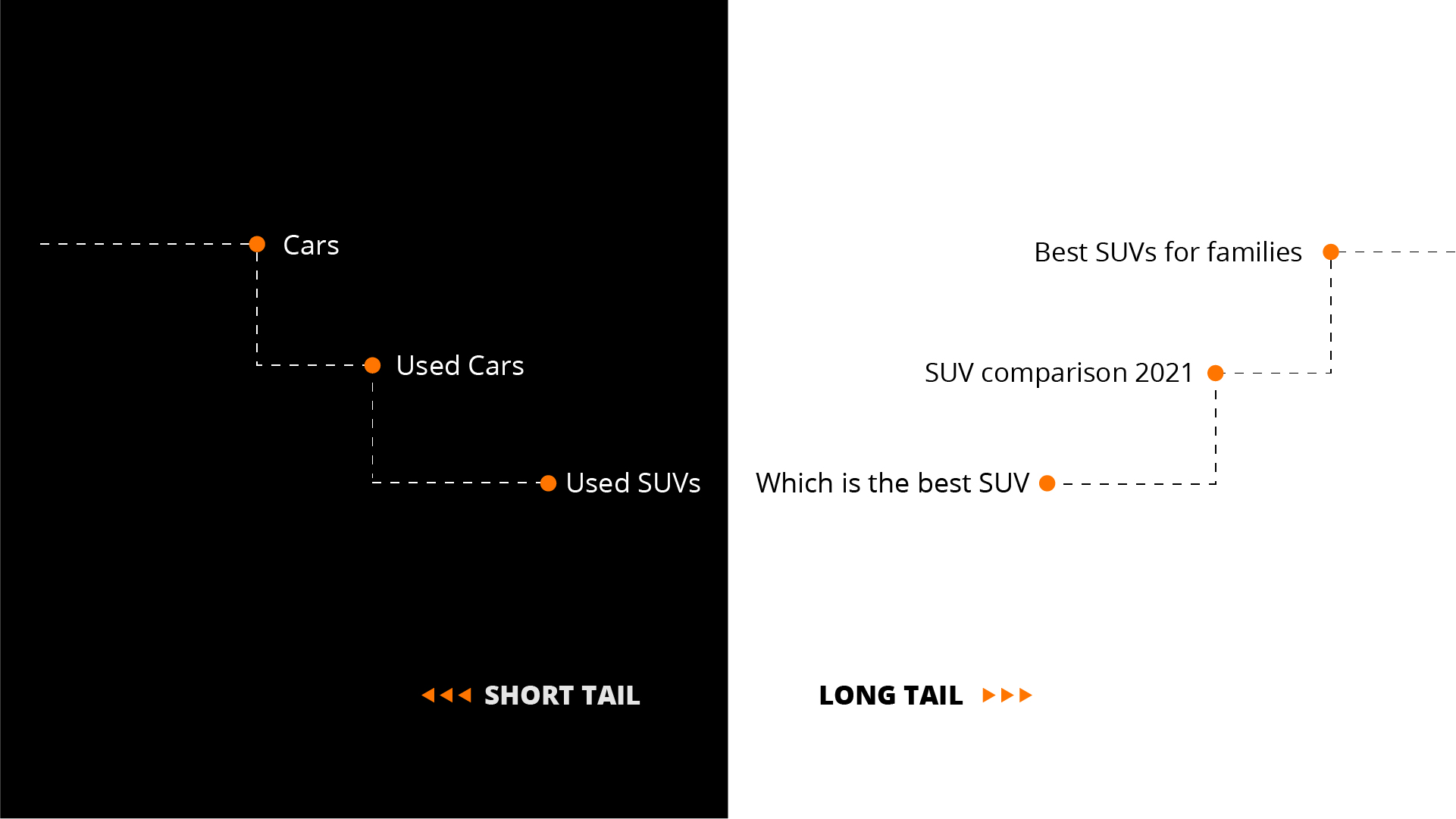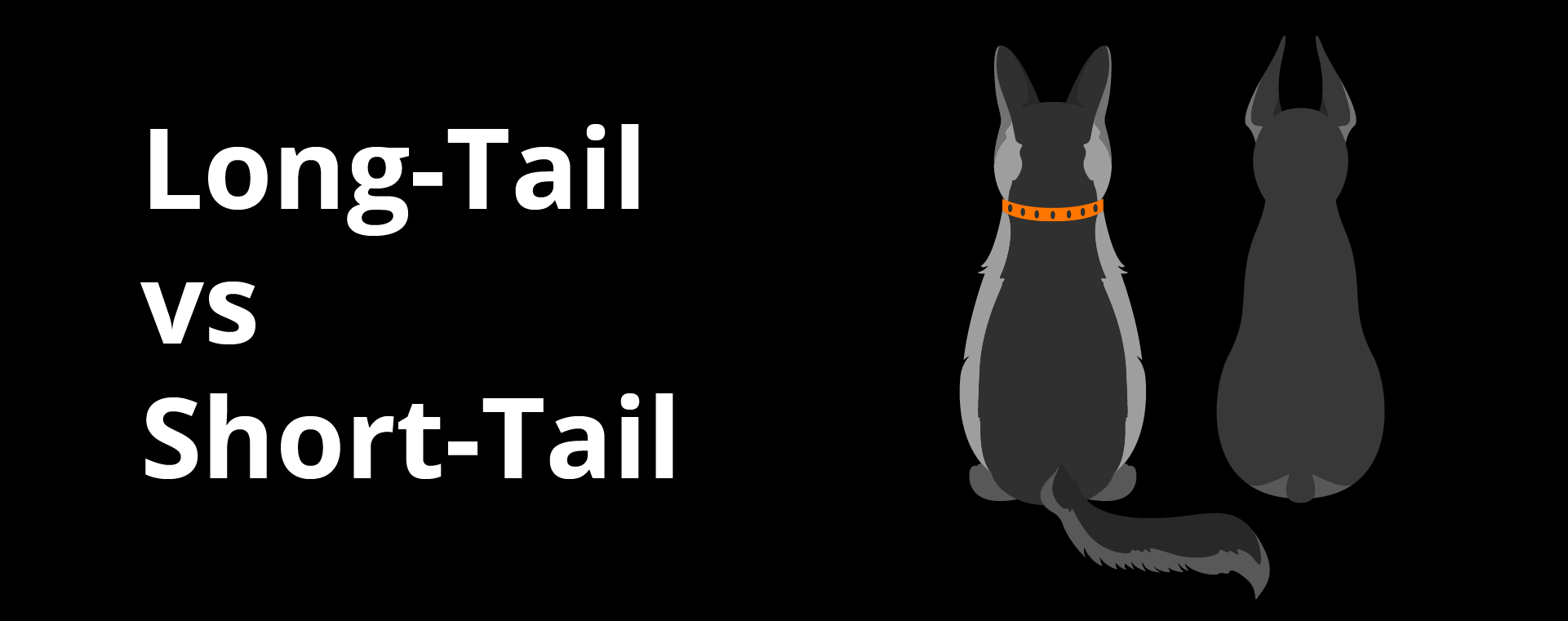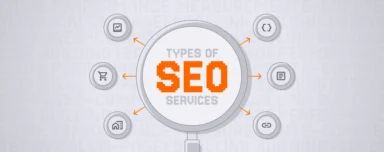Long-Tail vs. Short-Tail Keywords: What They Mean and Which is Better
You’ve probably heard terms like “long-tail” and “short-tail” keywords thrown around, but what do they mean? And more importantly, does it really matter which type you use?
What are Short-Tail Keywords?
Short-tail keywords are generic search terms consisting of one to two words that users are most likely to type into Google. These keywords are largely popular and can be found in millions of search queries each month. Because of their high search volume, these types of keywords offer a lot of traffic, but with that comes significantly more competition.
Examples of Short-Tail Keywords
Let’s say you’re in the market for a new car, and you head to Google to see what’s out there. The broadest short-tail keyword would be simply “cars.” This keyword has over 1.2 million searches monthly and roughly 6.6 billion search results. Even slightly more specific short-tail keywords like “used cars” or “SUVs” won’t narrow things down much, but these might help you find what you’re interested in.

What are Long-Tail Keywords?
Long-tail keywords are longer, more specific keyword phrases typically comprised of four to eight words strung together to narrow down a search to the most applicable results. Despite generating a smaller portion of individual searches, billions of long-tail keyword queries are generated monthly. The term “long-tail” refers to their position on the search demand curve, which we’ll explain shortly.
What Do Long-Tail Keywords Mean for Your Strategy?
Long-tail keyword phrases are essentially more conversational and specific ways people search when they know exactly what they want. They represent a user who has moved beyond general browsing and is looking for something particular.
Types of Long-Tail Keywords
Long-tail keywords can be categorized into two types:
Topical
These are the primary keywords of a piece of content and represent the most popular way to search for any given topic. For example: “digital marketing strategies” or “best running shoes for flat feet.”
Supporting
These are subtopics of a topical keyword, offering more elaboration and specificity. Content is often written targeting these because they’re much more specific and easier to rank for. For example: “effective B2B digital marketing strategies for lead generation” or “best budget running shoes for flat feet under $100.”
Examples of Long-Tail Keywords
Continuing with our vehicle search example, you can refine your search with specific long-tail keywords:
- “pre-owned Honda CR-V St Louis”
- “best fuel-efficient SUVs under $30000”
- “Toyota dealerships near me with certified mechanics”
- “how to negotiate car price at dealership”
These examples show how long-tail keywords can be questions, location-specific searches, or highly detailed product queries.
Why Use Long-Tail Keywords?
Benefits in SEO Context
Long-tail keywords offer several advantages for search engine optimization
- Easier to rank for: Thanks to lower search volume, there’s much less competition, making them an effective tactic for improving organic rankings
- Higher conversion rates: Users searching with long-tail keywords typically have clear intent and are further along in their buying journey
- Targeted traffic: You attract visitors who are specifically looking for what you offer
- Topical authority: Ranking for multiple related long-tail keywords helps establish your expertise in a niche
Benefits in PPC Context
In paid search campaigns, long-tail keywords provide significant advantages:
- Lower cost-per-click: Reduced competition means lower bidding costs
- Higher quality scores: More relevant, specific ads typically receive better quality scores
- Better ROI: Higher conversion rates combined with lower costs improve return on investment
- Less wasted spend: More precise targeting reduces irrelevant clicks
Understanding the Search Demand Curve
The names “short-tail” and “long-tail” come from their position on the “search demand” curve. There are few, largely popular keywords that can generate millions of monthly queries, putting them on the “short end” of the curve (think just typing in “shoes”). Millions of search queries take up the middle, with search volumes in the thousands (like “running shoes for women”).
Then, on the remaining portion of the curve – the “long tail” – live the billions of search queries that only generate a small number of monthly searches (like “Nike women’s running shoes with arch support”). Being on the long-tail end may mean fewer monthly searches, but you know you’re getting the quality, targeted audience you want for better results.
Understanding Search Intent & When To Use Each Type of Keyword
The key difference between long-tail and short-tail keywords is searcher intent. When you search “cars,” you’re probably in the early stages of your buying journey and just want to see what’s out there. It’s unlikely that you’d search for “cars” and immediately buy the first thing that pops up.
Rather, your search journey might progress like this:
- “cars” (research phase)
- “reliable SUVs” (narrowing options)
- “Honda CR-V reviews” (evaluating specific models)
- “Honda CR-V price St Louis” (ready to buy)
As you decipher between what you want and what you don’t want, your search becomes more focused, and the keywords get longer and more specific. While only a few people might search for “pre-owned Honda CR-V St Louis” in a given month, these searchers are ready to buy, making it a much more valuable interaction.
While long-tail keywords offer greater impact sooner, this doesn’t mean you should discount short-tail keywords entirely. However, be realistic about their implementation. Achieving top ten rankings using short-tail keywords can take years of content work and backlink outreach.
How to Find the Right Keywords
The perfect keyword strikes a balance. Broad enough to have search traffic behind it, yet specific enough to allow you to rank relatively easily.
If your keyword is too specific, like “low carb thin crust pizza restaurants that deliver to 902 South 5th Street,” no one is searching for it. If it’s too broad, like “pizza,” you’ll likely be relegated to the unexplored depths of Google’s search results.
You’ll want to optimize your site for specific keywords your potential customers will likely search. This might be “emergency plumbers near me,” “personal injury lawyer St Louis,” or “best wedding cake bakery in town.”
While you can use your best judgment when developing these keywords, you should use data to back up your decisions.
Keyword Research Tools
Various resources can help you determine potential traffic behind specific long-tail and short-tail keywords:
- Google Trends
- SEMrush
- Keywords Everywhere
- Google Keyword Planner
- Ahrefs
- Moz Keyword Explorer
Some are free, while others require a monthly subscription or credit purchases, so find the option that works best for your needs and budget.
Finding the Sweet Spot Between Volume & Competition
Keywords with lower volume don’t necessarily mean lackluster results. Instead, examining the keyword’s competition level will help you better determine how successful it will be.
In keeping with our pizza example, using more specific terms like “thin crust pizza delivery” or “low carb pizza near me” will naturally have less search traffic than “pizza.” However, the competition is virtually non-existent, so ranking for those more specific terms is perfectly within reach.
The Bottom Line
Both types of keywords are necessary, but they serve different purposes in your SEO and PPC strategies. Short-tail keywords help with brand awareness and reaching users in the early research phase, while long-tail keywords drive targeted traffic with higher conversion potential.
The smartest approach? Use both, but be strategic. Start with long-tail keywords to build initial rankings and authority, then gradually target more competitive short-tail terms as your domain authority grows.
At the end of the day, it’s all about finding that sweet spot between getting enough search traffic to matter and not biting off more than you can chew competition-wise. Pick keywords that actually make sense for your business and the people you’re trying to reach. No point ranking for something that won’t bring you the right customers, right?






